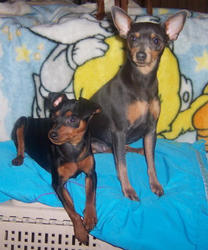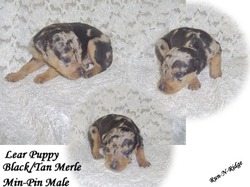

OUR GENTLEMEN (Duncan and Finlay)
|
Miniature pinscher colors. Sometimes it is hard to picture a color or how it looks from a person's description. This page will, hopefully, clearly illustrate the different minpin colors that we raise and make it easier to understand what I am meaning if we speak on the phone. First let me explain that a dilute colored dog is a dog affected by a dilution gene. This gene does what the name says. It dilutes the color. A blue dog is genetically a black dog, that is affected by the dilution gene turning the coat color into a grey. A fawn dog is genetically chocolate. A tan dog is genetically red. A dilute stag red is a blue stag, or a blue stag. Not only is the coat diluted, but the skin leather is also diluted on these different colors. Another difficulty in understanding a lot of this arises from the minpin club not bothering themselves with the dilute colors. I guess if they ignore it, it will all go away? At any rate there is some confusion about what the dilute colors are called. I have heard dilute reds called champagne fawns as well as tans. Inconsistency abounds in the color names. Names for colors vary from breed to breed. A chocolate minpin is the same color as a red doberman, and the base coat is the same as liver in some other breeds. While it is all fascinating, it can be a bit confusing. There are some common misconceptions out there about the dilute colors---blue in particular. Here is some information to help people with understanding about the blue color. 1. Blue can have skin/coat problems, BUT, others have good skin and coat. Some of this depends upon genetics, some on diet, and some on contentment. Happy dogs have better coats. 2. Blue can be AKC registered. 3. Blue can't be shown in the U.S., but can be in Canada and Great Britain. 4. A fawn has been successfully shown to championship status in Canada. 5. Breeding a blue dog to another minpin doesn't necessarily produce blue puppies. Both parents must carry the dilution gene to produce blue color. 6. Any color is only skin deep.
|
|
|
This is an example of a fawn and a chocolate puppy. A fawn puppy is one in which the chocolate color has been diluted. The dilution gene is a recessive gene that does what it says---dilutes the coat color. The fawn is born sort of a golden color, and darkens with age. Spook is much, much darker than she was at birth. The chocolate will stay about this color. The golden sheen on the coat of this fawn was normal for her. She sort of gleamed in the sun. There is something in the fawn coat that reflects the light differently somehow. |
|
| A blue and a black and rust. A blue is a dilute black and rust. The black color has been diluted down into a blue. Very striking to look at, and a real attention getter, some blue dogs do have skin or coat problems. Some of these problems are more common in different bloodlines. I believe on all of the dilute colors that the environment, and diet a lot to do with the quality of a dilute coat. |
|
|
Here is a clear red puppy. I see that I have failed to explain the difference between clear red and stag red. A clear red dog is a recessive red. A clear red can't have any black hair. One black hair means that a dog is a stag red. Stag reds are red dogs that have black hair in their coat (usually). In a lot of photos it is hard or impossible to tell if a dog is clear red or stag red. Just remember... any black hair makes a stag red. Clear red will never have any black hair. This can be a lovely color, and on a sweet pup. I just want to make a comment here. There is a question as to which is the "best" color of minpin. In my opinion, it is the color of your dog, or the color that YOU like. What I like for color might not be what you like. But ANY COLOR IS ONLY SKIN DEEP. I have seen beautiful dogs in every color. |
.jpg) |
|
Belle and Daughter This is a two year old blue beauty, a daughter of Amy and Riley. She has a wonderful dark blue coat, and is just generally beautiful. She is shown with her black and rust daughter. (Amy and Riley's grand daughter). She was sold to Cynthias Pups, and is living in Maryland. Take a good look at this girl, and you can see that blue is beautiful.
|
|
|
Dilute Red This little girl is a dilution of the clear red color. This is shown by the fact that the leather and skin on her body is a blue shade in areas where it would be black on a normal clear red color. She is registered with AKC as a tan. In the right lighting it is obvious that there is also a "peachy" shade to the red.
I am presenting here an over simplified list of minpin colors in order of dominance. Stag red is the most dominant of the minpin colors. Black and tan or black and rust is next in line, and therefore so is blue and tan. Chocolate is recessive to stag red and black, and so of course is fawn. The most recessive color is the clear red or dilute clear red. This can be confusing, as it sometimes seems backwards. Two clear reds bred together shouldn't produce much but clear red. Two chocolates bred together should only produce either chocolate, or occasionally clear red. And of course if the chocolates are dilute factored, the could also produce fawn or tan. A stag red, since it is a dominant color can also produce almost any color if the genes are hidden beneath the dominant stag red color. Recessive genes are tricky as they hide beneath the dominant genes, but can exhibit themselves in the right combination. A nice little book with an easy to understand section on minpin color genetics is by D. Caroline Coile. The title is Miniature Pinschers, A Complete Pet Owner's Guide. This is an inexpensive paperback book that is informative, and easily understood. It also has lots of nice photos. |
|
|
ANOTHER COLOR
Once the minpin was shown in blue and a color called harlequin. The harlequin color is called merle in other breeds. In about 1950 the merle and the blue color was determined to be a fault by the breed club. In about 1980 it was made to be a disqualification for the show ring. As a result of this ruling, the harlequin or merle color has largely become lost to the breed. As it was a semi-dominant gene it was easy to breed away from the color. The blue, being a recessive, was harder to eliminate from the gene pool. Nor do I think it should have been eliminated and today has made a comeback. Care must be taken to breed only good coated dogs. A small group of breeders has been quietly working to revive the harlequin color into today's minpin. These dogs, of course, can not be recognized by the AKC, nor the minpin club. A small pinch of blood from the rat terrier breed was used to bring back the merle color gene, but at present the percentage of pure minpin genetics would be more than 99%, with less than 1% from rat terrier. In most animals that is considered to be registerable purebred. In certain dog registries it is considered registerable purebred. Merle minpins will be registered with the ACR. Merle gene is a semi dominant gene, and if it is present can pattern any of the other minpin colors. Merle is also a semi lethal gene. Merle should not be bred with merle. Just a note to clarify... often merle is hard or impossible to see in red colored dogs. Dogs that are genetically merle, but don't show it are often called cryptic merle. For more info on this color, check out the Harlequin page on my website, as well as Seren's page. Seren is my red merle girl.
|
|
|
|
|

_250x240.jpg)
_250x187.jpg)

_201x250.jpg)
